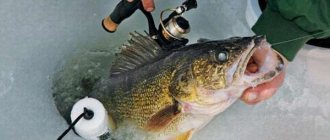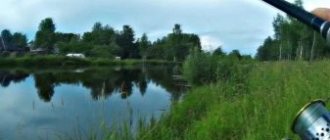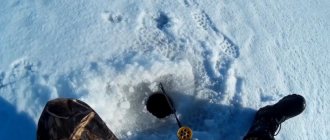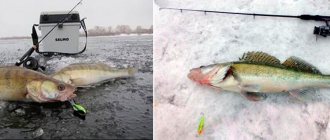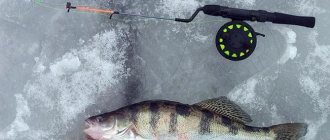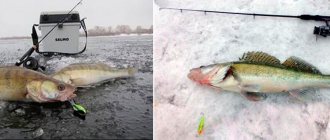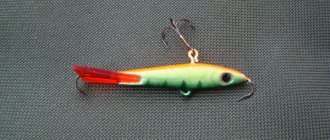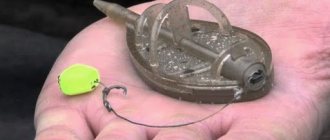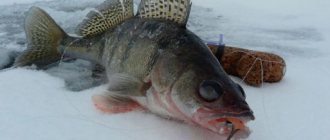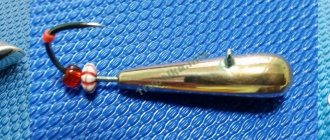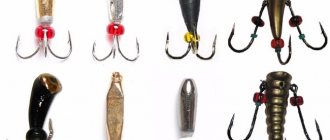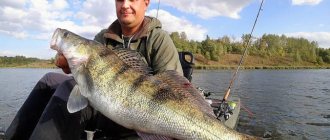To make winter fishing for pike perch a success, you need to know some of the behavioral features of this predatory fish. Winter fishing for pike perch, provided you know a few secrets, is always a lot of fun. To make winter fishing for pike perch a success, you need to know the behavioral characteristics of this predatory fish: where to catch pike perch in winter and how the weather affects the bite. Read about the success of using various baits and successful fishing for pike perch in winter in this article
UPD: Fisherman's calendar for January
Winter fishing for pike perch: Secrets of catching pike perch in winter
Sometimes several multi-colored cambrics placed on a hook greatly enliven the pike-perch bite.
Where to catch pike perch in winter
Pike perch is classified as a twilight and nocturnal fish. At the same time, he often switches to a daytime lifestyle. Another unusual feature of this predator is that, being a bottom-dwelling fish, it quite often hunts in the water column or near the surface, especially during collective attacks on concentrations of bleaks. Like all perch, pike perch is a schooling fish, preferring a collective method of hunting for fry. True, this applies mostly to small and medium-sized predators. Large individuals often prefer proud loneliness. Of course, except during spawning and in the pre-spawning period, when the male and female hunt forage fish together.
In the winter season, the best way to catch pike perch is by vertical trolling or fishing with a balance beam. I talked about how to catch it with a balancer here, so now we’ll talk about lures. However, pike perch is not caught everywhere and sometimes the angler has to move around a lot in search of an active predator. Choosing the right place is often the key to successful fishing.
When searching for fish, holes should be drilled, moving from shallow water to deeper areas of the reservoir. The fishing itself also begins at shallow depths, before dawn. Winter trolling for pike perch is very similar to winter pike fishing with spoons, however, this type of fishing also has some of its own characteristics. First of all, this is that the spoon should fall slowly, without jerking in different directions. In terms of color, light and yellow spinners are the most preferred for pike perch; many are successfully caught with two-color baits. For better performance of the bait, you can attach a swivel or an additional ring.
There are quite a lot of techniques for winter trolling for pike perch, and a fisherman should not get hung up on any one of them; it is much more effective to experiment with different techniques, complementing each other with them. The most common way to play a spinner is as follows: the bait is allowed to sink to the bottom, then gently raised by 20-40 cm, after which they make several strokes with the fishing rod, again raised by 10-15 cm, wait a short pause, then lower it slightly and hold the second, but already a shorter pause.
When repeatedly casting the bait, we change the pace of the game, noting to ourselves which of them is the most effective. The bait should always rise and fall sharply evenly. This way the spoon will be able to glide freely in the horizontal plane. It is believed that this behavior of the bait can provoke pike perch to attack.
Having caught one pike perch, do not rush to leave this place, because it often happens that at the fishing site there is a shelter such as a snag or a log, near which several predators can be present at the same time. If there are still no bites, then try to make several holes nearby, no more than two meters from the first one, and fish in them.
It happens that pike perch attacks the spoon, but is not detected. In this case, I recommend that you continue fishing in the same way, at the same pace, without changing the speed of the game. If the pike perch does not react, then drill several holes nearby and try to fish in them. If in this case there are no bites, then be sure to return to these holes after a few hours. There are often cases when such holes brought the majority of the production.
Looking for pike perch in a pond
When going winter fishing for pike perch, remember that pike perch prefer a hard sandy or gravel bottom. Especially when it comes to winter fishing for pike perch. However, we should not forget that the location of river, lake or reservoir pike perch will have its differences. I had to catch pike perch in winter in such reservoirs as Mozhaiskoye, Ruzskoye, Ozerninskoye, Rybinskoye and a number of others. I know typical pike perch places on these reservoirs. Usually these are sandy or rocky slopes in depth and there must be underwater snags, fallen and flooded trees, as well as other shelters.
Fishing for pike perch in open water
In late spring and early summer, the water in lakes, rivers and reservoirs heats up. It is during these weeks that pike perch spawn and spawn. A spawned pike perch becomes hungry, as it has lost a lot of strength to procreate. At this time, the season for successful fishing for pike perch begins. They fish for pike perch all summer and autumn.
Fishing takes place in the morning and evening hours, sometimes this fish can be caught during the night. Fishing for this predator using a float rod is interesting and exciting. The fisherman first catches live bait (ruff, gudgeon or pencil bee).
But wide-bodied fish, such as sorog, bream and silver bream, are not suitable as live bait. This is due to the fact that pike perch have a narrow throat. If fishing takes place in a strong current, then the live bait needs to be touched by the upper lip. But when fishing in a slow-flowing reservoir, the fry should be touched under the upper fin, behind the back of the live bait.
Zander spawning
Pike perch bites in a variety of ways. In quiet waters, he can lightly tug the float, as if to show that he is there. After this, he can be strongly dragged into the water. But there are other bites. On some fishing trips, it happens that the pike perch, when biting, gently moves the float and sinks it.
These peculiarities of fish biting are due to the fact that this predatory fish first holds the caught bait on the hook in its mouth for some time, and then the fanged one swims, swallowing the bait as it goes. At this second, you should feed the line without pulling it completely. After this, you need to hook with a strong swing of the rod.
When fishing, the pike perch offers strong resistance. He fights for life, trying to lie down under a boulder or snag. This should not be allowed under any circumstances, so as not to have to tear the fishing line with the hook. When fishing for pike perch, an experienced fisherman always uses a reliable fishing line from a trusted manufacturer and boldly brings the pike perch to the shore or into the boat.
Large pike perch catch
The landing net, of course, must be ready. If the fishing takes place in the rapids, then the pike perch bites very energetically. The float immediately moves sideways or against the current, and then dives into the water. Fishing for fanged fish takes place not only with float gear, but also with bottom gear.
Live bait, crawling worms, and larvae are used as bait. When choosing a location, preference should be given to areas of the reservoir with an average current, below the riffles. Lake pike perch are successfully caught with medium-sized mugs, compared to catching pike with mugs.
Winter fishing for pike perch using lures
I think I won’t be wrong if I say that most hunters for winter pike perch started by catching pike perch with a spoon. It is best to shine from the ice until it reaches a thickness of 40–50 cm. In the middle of winter, after the Christmas and Epiphany frosts, drilling holes is already difficult. In this situation, experienced anglers usually catch pike perch in well-known places where there are various bottom irregularities that pike perch use as ambushes.
I caught my first winter pike perch many years ago and completely by accident. It happened at the Mozhaisk Reservoir. When dawn had just broken, my friend and I followed our old tracks to the place where the previous evening we had left several girders for the night, putting live bait on the bottom in hopes of catching burbot. But none of them worked, and we raised the live baits about half a meter above the bottom. Yuri went closer to the shore to look for perch, and I drilled a hole next to one of the girders and decided to attract pikes by playing with a spinner.
My calculation was extremely simple. If an intrigued predator ignores my “piece of iron”, she will probably grab a pot-bellied caviar brush on the tee of the girder. After I diligently demonstrated about a dozen techniques for playing with bait, I decided to go to a friend’s place to catch perch. But what is it? While lifting the spoon from the bottom, I felt a couple of light knocks through the fishing rod, and then a hanging heaviness. Bite! I hook quite sharply and start fishing.
Out of surprise, I drag the fish right through. And then the narrow-nosed head of a pike perch with “glassy” eyes appears in the hole, and a moment later it sluggishly tosses and turns on the ice. Offhand, it weighs about two kilograms. There is no limit to joy. I'll flash further. But, alas. My spiny-feather turned out to be the one and only. Or perhaps he was one of a fast-moving pack.
For sprat
In the Volga basin, pike perch are often caught using sprat. This fish is the main food source for fanged fish in the Volga basin. Live sprat can be used as live bait on the bottom, but more often frozen fish from the store are used for hooking onto a spoon, jig or hook. This is convenient for the townspeople of the Volga region - I bought frozen sprat in a department store - and there is no need to fool myself with searching for live bait or other bait. Yes, and the striped one on the Volga takes well on sprat. Most often, the sprat is planted on the hook of a diverter leash, a jig head, a jig or a special tackle. There's a lot going on here. You can also fish for pike perch in winter for fry in other regions, using fish species found in the reservoirs of those places. It doesn’t hurt to check the sprat, even if it’s not found there. You can also try frozen capelin or sprat.
Technique for catching pike perch with a spoon
Winter pike perch moves less often and requires much less food. There is such a thing as metabolism (metabolism in the body). A well-fed and a hungry predator are not the same thing. It happens that after a short meal, a school of pike perch slowly digests food for two to three days. Is it realistic to challenge the fanged one to grab him in such a situation? For example, I have repeatedly managed to activate the bite by using the irritation technique.
Its essence is as follows. After the spoon reaches the bottom, you smoothly lift it 40–50 cm, and then, after a pause (5–7 seconds), drop it sharply. The spoon moves away from the vertical axis of the retrieve and freezes, fluttering, 5–10 cm from the bottom. It is precisely this behavior of the bait that often causes the passive pike perch to bite.
It is imperative to maintain a pause of 5–10 seconds in the upper position of the spoon, since pike perch does not always hunt in the bottom layers of water. There is only one condition: try to avoid sharp movements of the spoon in the water column. This will only alert you and scare away the prickly-feathered predator.
Winter pike perch fishing technique
After the spoon reaches the bottom, it is smoothly raised 40–50 cm, and then, after a 5–7 second pause, it is sharply lowered to the bottom. The spoon deviates to the side and begins to glide 5–10 cm from the bottom. A pause in the upper position of the spoon should be maintained, since pike perch does not always hunt at the bottom. Sometimes, in order to attract the attention of the pike perch and force it to attack, you can attach a piece of white fish to the hook of the spoon.
Recently, balancers have become increasingly popular for winter fishing for pike perch; their movement during play perfectly imitates the behavior of small fish. Their dimensions (weight, length) depend, first of all, on the strength of the current and the depth of the fishing spot. It is not difficult to play with a balancer; first it lowers to the bottom, and then rises 10–15 cm, followed by a short swing of the fishing rod. It’s a good idea to tap the bottom, creating a cloud of turbidity.
Catching pike perch using a spinner with a float
Many advanced pike-perch fishermen do not attach importance to the fact that a hunting school of pike-perch (usually small ones) moves quite quickly after the food fish (small roach, gudgeon, bleak) and it is important to do everything very quickly after the first bite. In this case, a spindle-shaped float can provide an invaluable service, which fixes the depth of descent of the spoon at 10–15 cm from the bottom.
With a float it is also easy to maintain the required depth when pike perch hunt in the water column. Quite often bites occur while playing with a float. At the same time, it should have almost zero buoyancy, that is, when the spoon is lowered to the desired depth, it should go slightly deeper and then slowly float up. When rising up, a bite usually follows.
How to find pike perch in winter
The ice was reliable, so we could safely go after the winter predator on the fairway.
It was not possible to fish all promising areas. I had to narrow down the search area. Modern technologies also helped out. Downloading information about this section of the Volga channel from the Internet is a matter of seconds. And then you need to carefully study the map, look at your old trolling fishing records and make a reference to the area.
A large group of people went out on the ice, so it was easier to actively look for fish, and at the same time test all sorts of ideas and share impressions. The Kashirskaya pit was quite compact, so we decided to start there. It is remote from populated areas and there are almost no fishermen there. Then, as in other larger holes located upstream, there are always many people who want to catch pike perch.
This pit indeed turned out to be very promising. It was no more than twenty-five meters deep, but there were raised areas around, with depths ranging from ten to fourteen to fifteen meters. The beginning of the hole is a sharp drop in the bottom from fifteen to 20 meters. The edge of the edge is located perpendicular to the general direction of the flow. The exit from the pit is gentle, just like a comet with a core and a long tail. The width of the pit is about 100-150 meters, the length is almost five hundred meters. Above the pit, the depth gradually decreased, especially towards the banks. But there were small depressions and hills.
The fishermen were unable to study the nature of the currents in front of the hole and in it itself, but from experience they assumed that near a sharp drop the river flow swirls strongly and slows down. It often happens that it is at the beginning of the holes that flocks of riverbed predators stand. This place looked promising. We decided not to go far from the beginning of the pit and try to fish above the sharp drop.
To understand the bottom topography, I had to spend time drilling dozens of holes—measuring depths. Years of fishing have taught us that the location of fish in a body of water is determined by its structure and the nature of the currents.
Winter fishing for pike perch using balance beams
Compared to the last century, the arsenal of winter baits for catching predatory fish has been significantly updated. If previously, the overwhelming majority of pike-perch fishermen used vertical spinners and so-called mirror bullets with dead fish, now you can see fishermen on the ice equipped with the most modern baits.
First of all, these are balancers. The success of catching pike perch with these baits, as it seems to me, is explained by the fact that in reservoirs frequently visited by fishermen, pike perch become accustomed to traditional baits, if not afraid of them. It can be assumed that a pike perch that has reached the age of 5–6 years has repeatedly dealt with inedible “pieces of iron.” In addition, pike perch, which usually hunt in schools, cannot help but react when one of their fellows leaves the school after catching a spoon, sending signals of danger to the others. As a result, the instinct of self-preservation is triggered. Where fanged predators do not experience severe pressure from anglers, metal spoons are still in use.
Of course, balancers have an undeniable advantage in that with their movements during the game they most reliably imitate the behavior of small fish.
The size of pike-perch balancers is most often in the range from 5 to 12 cm. Moreover, even small pike-perch sometimes clings to a large balancer, especially when fishing at a depth of more than five meters. The weight of the bait depends on the strength of the current. On reservoirs I use balancers weighing from 8 to 20 g.
As we have already said, outbreaks of pike perch bite occur both at dawn and during the day. On some reservoirs, fanged fish come out to feed at certain hours and with enviable consistency. Experienced fishermen take this into account.
The technique of catching pike perch is not much different from perch fishing. First, we lower the balancer to the bottom, raise it by 10–15 cm and make a short swing with the fishing rod. If the bottom is slightly silted, from time to time it is useful to knock on the ground, raising fountains of turbidity. When fishing from ice, it is undesirable for the balancer to quickly write out figure eights. This will scare away rather than attract the spiny-finned predator. If there are no bites, fish other horizons. Pike perch hunts not only in bottom layers of water.
Lures for winter fishing for pike perch
Most winter pike perch anglers use spoons. The weight of the spoon should be selected taking into account the depth and strength of the current. To catch pike perch in reservoirs, the bait should weigh no more than 20 g. When making such a bait, one plate (of brass, copper, cupronickel) 0.5-0.7 mm thick is used, after preliminary tinning, about 15 grams of lead solder is applied to it. And when going, for example, for pike perch to the Volga, where the river current is strong, the weight of the bait must be increased to 50 g.
